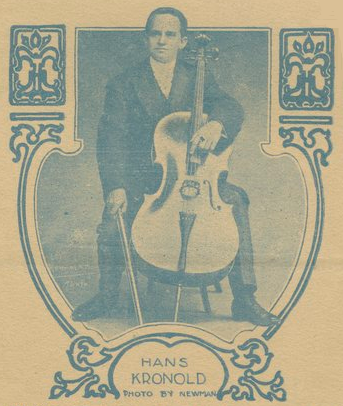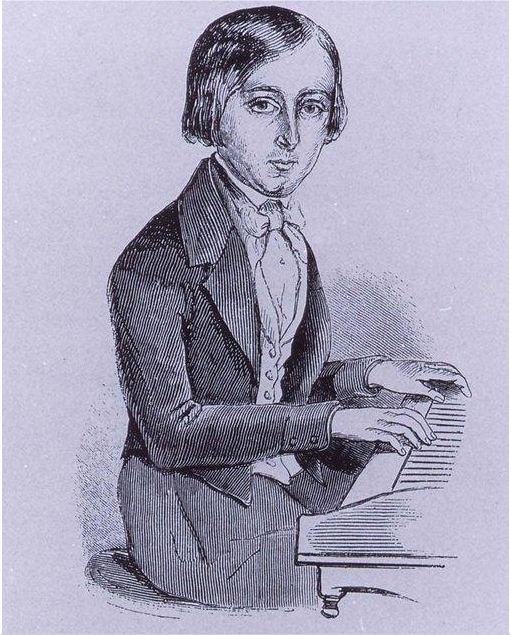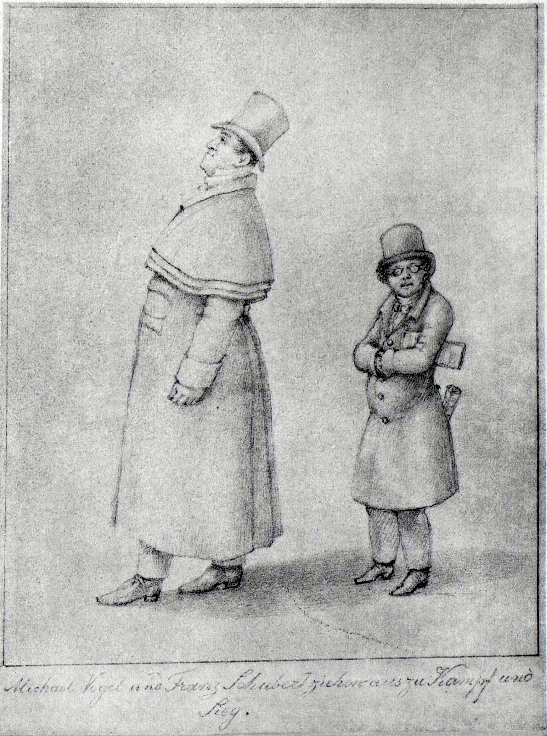|
Hans Kronold
Hans Kronold (3 July 1872 – 10 January 1922) was a Polish-born Jewish cellist, composer, educator, and a member of symphony orchestras of New York and Boston. He was the first cellist to have his work recorded on audio, which he did for recording pioneer Gianni Bettini phonograph cylinders in the 1890s. Life and career Kronold was born in Kraków to Adolph Kronold and Louise (Hirschberg) Kronold. His sister was the opera soprano Selma Kronold; a cousin of Polish pianist and composer Moritz Moszkowski. He had his first musical training in Leipzig, where he studied with Max Kiesling (1866–1930). He lived in Berlin for three years, where he extended his musical education with Professor Richard Vollrath, and piano and harmony with Hans Rasch. In 1886, he emigrated to New York, resuming his studies with cellist Anton Hekking, and S. Vreeman. Kronold soon joined the Metropolitan Opera and shortly after the New York Symphony Orchestra, where he played for five consecutive seasons ... [...More Info...] [...Related Items...] OR: [Wikipedia] [Google] [Baidu] |
The Saratogian
''The Saratogian'' is a broadsheet-style daily newspaper published in Saratoga Springs, New York, United States. The paper has been published daily since 1855, first as ''The Daily Saratogian'', and then as ''The Saratogian'' beginning in 1910. It covers all of Saratoga County, New York and specifically the city of Saratoga Springs. It includes the ''Pinksheet'' in the summer, which has information about what will happen at the Saratoga Race Course that very day. The Saratogian was owned by Gannett from 1934 to 1998, when it was sold to the Journal Register Company, now known as 21st Century Media, a subsidiary of Digital First Media. Digital is controlled by Alden Global Capital Alden Global Capital is a hedge fund based in Manhattan, New York City. It was founded in 2007 by Randall D. Smith, and is a division of Smith Management LLC. Its managing director is Heath Freeman. By mid-2020, Alden had stakes in roughly two ... which has a practice of reducing staff and draining ... [...More Info...] [...Related Items...] OR: [Wikipedia] [Google] [Baidu] |
Oliver Ditson
Oliver Ditson (October 20, 1811 – December 21, 1888) was an American businessman and founder of Oliver Ditson and Company, one of the major music publishing houses of the late 19th century. Early life and career Oliver Ditson was born in Boston, Massachusetts, of Scottish ancestry, on October 20, 1811. His parents lived near the home of Paul Revere at the lower end of Hanover Street. In 1823, just out of grammar school, Oliver became an employee of Col. Samuel Hale Parker, father of J.C.D. Parker, the organist and composer. Col. Parker owned a book store on Washington street, near Franklin Street in Boston, and kept in addition to his regular stock a few pieces of music. At the time the Waverley novels were making their appearance and Col. Parker was republishing them as rapidly as they could be gotten from England. Oliver left the bookstore to master the printer's trade. About 1834, fire destroyed the store of Col. Parker. With what was saved he moved with his now indis ... [...More Info...] [...Related Items...] OR: [Wikipedia] [Google] [Baidu] |
Charles Gounod
Charles-François Gounod (; ; 17 June 181818 October 1893), usually known as Charles Gounod, was a French composer. He wrote twelve operas, of which the most popular has always been ''Faust (opera), Faust'' (1859); his ''Roméo et Juliette'' (1867) also remains in the international repertory. He composed a large amount of church music, many songs, and popular short pieces including his "Ave Maria (Bach/Gounod), Ave Maria" (an elaboration of a Johann Sebastian Bach, Bach piece) and "Funeral March of a Marionette". Born in Paris into an artistic and musical family, Gounod was a student at the Conservatoire de Paris and won France's most prestigious musical prize, the Prix de Rome. His studies took him to Italy, Austria and then Prussia, where he met Felix Mendelssohn, whose advocacy of the music of Bach was an early influence on him. He was deeply religious, and after his return to Paris, he briefly considered becoming a priest. He composed prolifically, writing church music, songs ... [...More Info...] [...Related Items...] OR: [Wikipedia] [Google] [Baidu] |
Ave Maria (Bach/Gounod)
"Ave Maria" is a setting of the Latin prayer Ave Maria, originally published in 1853 as "". The piece consists of a melody by the French Romantic composer Charles Gounod that he superimposed over an only very slightly changed version of Bach's Prelude No. 1 in C major, BWV 846, from Book I of his ''The Well-Tempered Clavier'', 1722. The 1853 publication has French text, but it is the 1859 version with the Latin "Ave Maria" which became popular. History Gounod improvised the melody, and his future father-in-law Pierre-Joseph-Guillaume Zimmerman transcribed the improvisation and in 1853 made an arrangement for violin (or cello) with piano and harmonium. The same year it appeared with the words of Alphonse de Lamartine's poem "" ("The Book of Life"). In 1859, Jacques-Léopold Heugel published a version with the familiar Latin text. The version of Bach's prelude used by Gounod includes the "Schwencke measure" (m.23), a measure allegedly added by Christian Friedrich Gottlieb Sch ... [...More Info...] [...Related Items...] OR: [Wikipedia] [Google] [Baidu] |
Cécile Chaminade
Cécile Louise Stéphanie Chaminade (8 August 1857 – 13 April 1944) was a French composer and pianist. In 1913, she was awarded the Légion d'Honneur, a first for a female composer. Ambroise Thomas said, "This is not a woman who composes, but a composer who is a woman." Biography Born in Batignolles (a village then outside Paris), Chaminade was raised in a musical family. She received her first piano lessons from her mother. Around age 10, Chaminade was assessed by Félix Le Couppey of the Conservatoire de Paris, who recommended that she study music at the Conservatoire. Her father forbade it because he believed it was improper for a girl of Chaminade's class. Her father did, however, allow Chaminade to study privately with teachers from the Conservatoire: piano with Le Couppey, violin with Martin Pierre Marsick, and music composition with Marie Gabriel Augustin Savard and Benjamin Godard. Chaminade experimented in composition as a young child, composing pieces for her cats ... [...More Info...] [...Related Items...] OR: [Wikipedia] [Google] [Baidu] |
Francis Thomé
Francis Thomé (18 October 1850 – 16 November 1909), was a French pianist and composer. He was born in Port Louis, Mauritius, and studied at the Paris Conservatoire with Jules Duprato and Ambroise Thomas. After leaving the Conservatoire, he became well known as a composer of salon pieces and was in demand as a pianist and teacher. His music was particularly successful in the French provinces, and two of his operas were first performed outside Paris. He became popular towards the end of the 19th century as a composer of accompanied poems, but is also known for his stage works, which encompassed various genres, including ballet, pantomime, incidental music (for a wide range of plays), bluettes, and operettas, such as ''Le Baron Frick'' (1885), the latter collaboration with Ernest Guiraud, Georges Pfeiffer, and Victorin de Joncières. References Sources * Article by David Charlton in the ''New Grove Dictionary of Opera ''The New Grove Dictionary of Opera'' is an encyclopedia ... [...More Info...] [...Related Items...] OR: [Wikipedia] [Google] [Baidu] |
Camille Saint-Saëns
Charles-Camille Saint-Saëns (, , 9October 183516 December 1921) was a French composer, organist, conductor and pianist of the Romantic music, Romantic era. His best-known works include Introduction and Rondo Capriccioso (1863), the Piano Concerto No. 2 (Saint-Saëns), Second Piano Concerto (1868), the Cello Concerto No. 1 (Saint-Saëns), First Cello Concerto (1872), ''Danse macabre (Saint-Saëns), Danse macabre'' (1874), the opera ''Samson and Delilah (opera), Samson and Delilah'' (1877), the Violin Concerto No. 3 (Saint-Saëns), Third Violin Concerto (1880), the Symphony No. 3 (Saint-Saëns), Third ("Organ") Symphony (1886) and ''The Carnival of the Animals'' (1886). Saint-Saëns was a musical prodigy; he made his concert debut at the age of ten. After studying at the Paris Conservatoire he followed a conventional career as a church organist, first at Saint-Merri, Paris and, from 1858, La Madeleine, Paris, La Madeleine, the official church of the Second French Empire, Fr ... [...More Info...] [...Related Items...] OR: [Wikipedia] [Google] [Baidu] |
Le Cygne
"Le cygne", , or "The Swan", is the 13th and penultimate movement of ''The Carnival of the Animals'' by Camille Saint-Saëns. Originally scored for solo cello accompanied by two pianos, it has been arranged and transcribed for many instruments but remains best known as a cello solo. Music The piece is in 6/4 (time signature), with a key signature of G major and a tempo marking ''andantino grazioso''. The slow cello melody is accompanied by almost constant broken chord figurations on the pianos. When performed as a separate movement, not in the context of ''The Carnival'', "The Swan" is frequently played with accompaniment on only one piano. This is the only movement from ''The Carnival of the Animals'' that the composer allowed to be played in public during his lifetime. He thought the remaining movements were too frivolous and would damage his reputation as a serious composer. "Le cygne" illustrates the fleeting nature of beauty with its interpretation of the legend of the ... [...More Info...] [...Related Items...] OR: [Wikipedia] [Google] [Baidu] |
Robert Schumann
Robert Schumann (; ; 8 June 181029 July 1856) was a German composer, pianist, and music critic of the early Romantic music, Romantic era. He composed in all the main musical genres of the time, writing for solo piano, voice and piano, chamber music, chamber groups, orchestra, choir and the opera. His works typify the spirit of the Romantic era in German music. Schumann was born in Zwickau, Saxony, to an affluent middle-class family with no musical connections, and was initially unsure whether to pursue a career as a lawyer or to make a living as a pianist-composer. He studied law at the universities of Leipzig University, Leipzig and Heidelberg University, Heidelberg but his main interests were music and Romantic literature. From 1829 he was a student of the piano teacher Friedrich Wieck, but his hopes for a career as a virtuoso pianist were frustrated by a worsening problem with his right hand, and he concentrated on composition. His early works were mainly piano pieces, inclu ... [...More Info...] [...Related Items...] OR: [Wikipedia] [Google] [Baidu] |
Kinderszenen
' (, "Scenes from Childhood"), Opus number, Op. 15, by Robert Schumann, is a set of thirteen pieces of music for piano written in 1838. History and description Schumann wrote 30 movements for this work but chose 13 for the final version. The unused movements were later published in Bunte Blätter, ''Bunte Blätter'', Op. 99, and ''Albumblätter (Schumann), Albumblätter'', Op. 124. Schumann initially intended to publish ''Kinderszenen'' together with ''Novelletten (Schumann), Novelletten'' (Opus 21); the shared literary theme is suggested by the original title ''Kindergeschichten'' (Children's Tales). He told his wife Clara Schumann, Clara that the "thirty small, droll things", most of them less than a page in length, were inspired by her comment that he sometimes seemed "like a child". He described them in 1840 as "more cheerful, gentler, more melodic" than his earlier works. Movement No. 7 of the work, ', is one of Schumann's best known pieces; it is the opening and closi ... [...More Info...] [...Related Items...] OR: [Wikipedia] [Google] [Baidu] |
Franz Schubert
Franz Peter Schubert (; ; 31 January 179719 November 1828) was an Austrian composer of the late Classical period (music), Classical and early Romantic music, Romantic eras. Despite his short life, Schubert left behind a List of compositions by Franz Schubert, vast ''oeuvre'', including more than 600 ''Lieder'' (art songs in German) and other vocal works, seven complete symphonies, sacred music, operas, incidental music, and a large body of piano and chamber music. His major works include "Erlkönig (Schubert), Erlkönig", "Gretchen am Spinnrade", and "Ave Maria (Schubert), Ave Maria"; the Trout Quintet, ''Trout'' Quintet; the Symphony No. 8 (Schubert), Symphony No. 8 in B minor (''Unfinished''); the Symphony No. 9 (Schubert), Symphony No. 9 in C major (''Great''); the String Quartet No. 14 (Schubert), String Quartet No. 14 in D minor (''Death and the Maiden''); the String Quintet (Schubert), String Quintet in C major; the Impromptus (Schubert), Impromptus for solo piano; the S ... [...More Info...] [...Related Items...] OR: [Wikipedia] [Google] [Baidu] |




